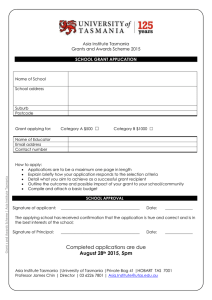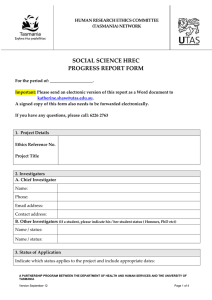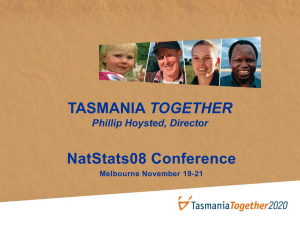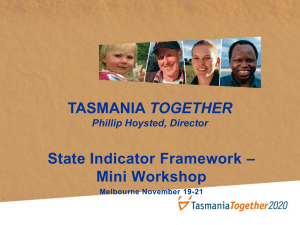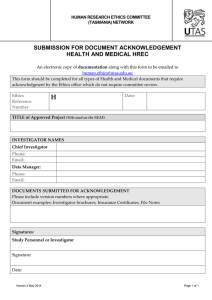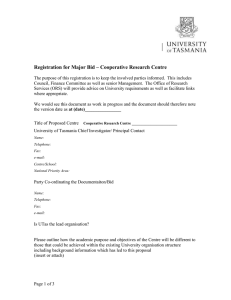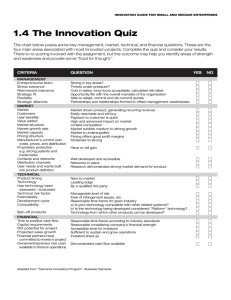Social Science HREC Full Application (169.7 KB)
advertisement
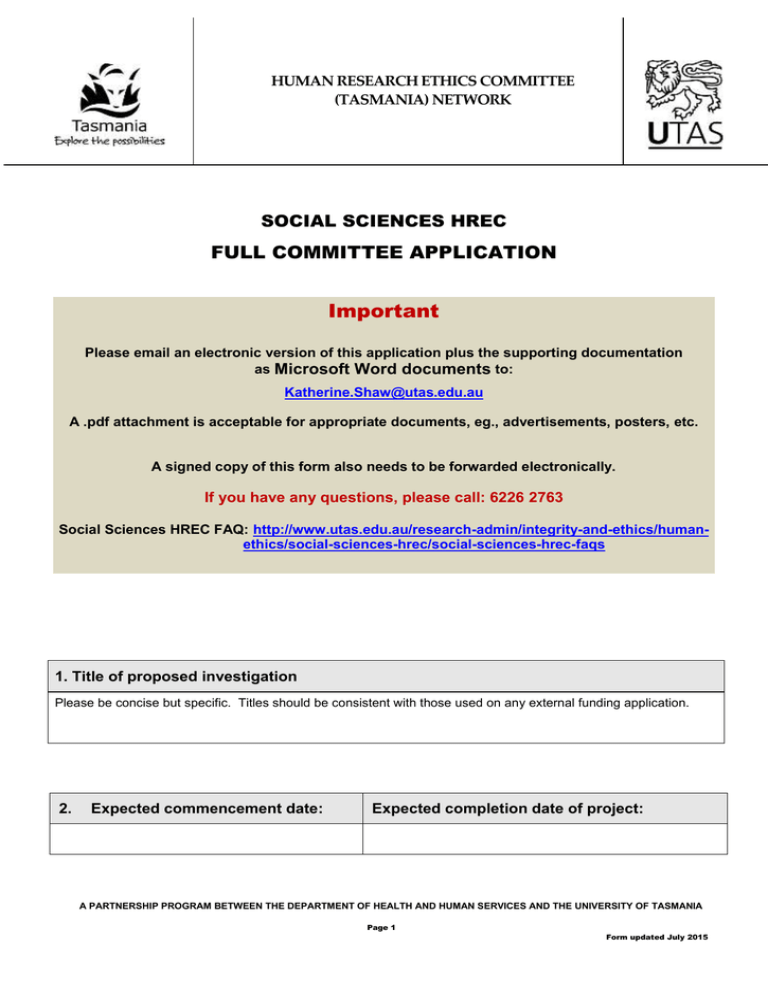
HUMAN RESEARCH ETHICS COMMITTEE (TASMANIA) NETWORK SOCIAL SCIENCES HREC FULL COMMITTEE APPLICATION Important Please email an electronic version of this application plus the supporting documentation as Microsoft Word documents to: Katherine.Shaw@utas.edu.au A .pdf attachment is acceptable for appropriate documents, eg., advertisements, posters, etc. A signed copy of this form also needs to be forwarded electronically. If you have any questions, please call: 6226 2763 Social Sciences HREC FAQ: http://www.utas.edu.au/research-admin/integrity-and-ethics/humanethics/social-sciences-hrec/social-sciences-hrec-faqs 1. Title of proposed investigation Please be concise but specific. Titles should be consistent with those used on any external funding application. 2. Expected commencement date: Expected completion date of project: A PARTNERSHIP PROGRAM BETWEEN THE DEPARTMENT OF HEALTH AND HUMAN SERVICES AND THE UNIVERSITY OF TASMANIA Page 1 Form updated July 2015 3. Investigators (a) Chief Investigator Note: This is the researcher with ultimate responsibility for the research project. The Chief Investigator cannot be a student. Given Name Surname Staff Position: Qualifications: Staff ID: School & Division: Contact Address: Telephone: Email: (Required) (b) Co-Investigator(s) i) Given Name Surname Staff Position: Qualifications: Staff ID: Contact Address: Telephone: Email: (Required) ii) Given Name Surname Staff Position: Qualifications: Staff ID: Contact Address: Telephone: Email: (Required) A PARTNERSHIP PROGRAM BETWEEN THE DEPARTMENT OF HEALTH AND HUMAN SERVICES AND THE UNIVERSITY OF TASMANIA Page 2 Form updated July 2015 (c) Student Investigator(s): Surname i) Given Name Gender: Date of Birth: Student Number: Preferred Title: Mr / Ms / Miss /Mrs /Dr Level: Undergraduate / Honours / Masters / Postgraduate Diploma / DBA / PhD Contact Address: Telephone: Email: (Required) ii) Given Name Gender: Surname Date of Birth: Student Number: Preferred Title: Mr / Ms / Miss /Mrs /Dr Level: Undergraduate / Hons / Masters / Postgraduate Diploma / DBA / PhD Contact Address: Telephone: Email (Required) (d) Conflicts of Interest Do any of the researchers have a conflict of interest, or what could be perceived as a conflict of interest? (NS 5.4) Yes No A conflict of interest in the context of research exists where: a person’s individual interests or responsibilities have the potential to influence the carrying out of his or her institutional role or professional obligations in research; or an institution’s interests or responsibilities have the potential to influence the carrying out of its research obligations. A perception that a conflict of interest exists can be as serious as an actual conflict. A PARTNERSHIP PROGRAM BETWEEN THE DEPARTMENT OF HEALTH AND HUMAN SERVICES AND THE UNIVERSITY OF TASMANIA Page 3 Form updated July 2015 If YES – please provide details: Please describe the nature of the conflict. Please describe how the conflict will be managed. 4. Research Merit HRECs are required by the National Statement to ensure all applications meet the requirement for ‘research merit and integrity’. In the introduction to Chapter 1 the National Statement says: “Unless proposed research has merit, and the researchers who are to carry out the research have integrity, the involvement of human participants in the research cannot be ethically justifiable”. Chapter 1.2, however, notes that: “Where prior peer review has judged that a project has research merit, the question of its research merit is no longer subject to the judgement of those ethically reviewing the research”. Research projects should therefore be effectively reviewed for academic merit before the application reaches the HREC. In this section of the application form, we ask applicants to assure the HREC that the research proposal (including the aims and methodology) has undergone a sufficiently rigorous review of its academic merit. A thorough review of the ethics application is not the purpose of this section. Where applications do not convincingly demonstrate adequate review of the project’s academic merit, the HREC may seek an independent review of academic merit from an expert the Committee deems appropriate. Is this research project being undertaken as part of: A PhD or Masters thesis (under supervision). Please complete section 4A below. An Honours thesis (under supervision). Please complete section 4B below. An academic/government research project. Please complete section 4C below. 4A School approval for PhD/Masters by Research Thesis Has the research proposal for this project (not the ethics application) successfully completed a full School review for research merit by people with relevant expertise who are not named as investigators on this application? Please note that sign-off by the Head of School is not sufficient, by itself, to constitute School approval. Yes Continue on to questions below A PARTNERSHIP PROGRAM BETWEEN THE DEPARTMENT OF HEALTH AND HUMAN SERVICES AND THE UNIVERSITY OF TASMANIA Page 4 Form updated July 2015 No Do not submit this ethics application until School approval is complete Has the HDR candidate successfully completed confirmation of candidature for the research project underpinning this ethics application? Yes No Date of confirmation of candidature completion: Continue on to questions below If candidature has not been confirmed, what was the nature of the School approval? Now continue on to questions below: Did this School approval process ensure that the project: Has a set of clearly identified aims? Is well designed and methodologically sound? Is based on a thorough review of the current literature and previous studies on related topics? (NS 1.1(c)) Has been designed or developed using methods appropriate for achieving its stated aims? (NS 1.1(b)) Is expected to yield valid and useful data, if conducted according to the protocol? Will be conducted or supervised by persons with appropriate experience, qualifications and competence? (NS 1.1(e)) Is justifiable by its potential benefit? (NS 1.1(a)) What recommendations (if any) were made concerning the proposal during the School approval process? How were these recommendations acted upon? 4B School approval for Honours thesis Has the research proposal for this project (not the ethics application) successfully completed a full School Honours review for research merit by people (or a person) with relevant expertise who are not named as investigators on this application? Please note that sign-off by the Head of School is not sufficient, by itself, to constitute School approval. Yes Continue on to questions below A PARTNERSHIP PROGRAM BETWEEN THE DEPARTMENT OF HEALTH AND HUMAN SERVICES AND THE UNIVERSITY OF TASMANIA Page 5 Form updated July 2015 No Do not submit this ethics application until School approval is complete What did this school review involve (what did you do to receive School approval)? Did this School approval process ensure that the project: Has a set of clearly identified aims? Is well designed and methodologically sound? Is based on a thorough review of the current literature and previous studies on related topics? (NS 1.1(c)) Has been designed or developed using methods appropriate for achieving its stated aims? (NS 1.1(b)) Is expected to yield valid and useful data, if conducted according to the protocol? Will be conducted or supervised by persons with appropriate experience, qualifications and competence? (NS 1.1(e)) Is justifiable by its potential benefit? (NS 1.1(a)) In Schools or Disciplines where Honours projects can be approved on the basis of review by a single academic staff member, the Committee will require written confirmation (an email is fine) from that reviewer that s/he: Has reviewed the research proposal itself (not merely the ethics application) Is satisfied that the project as described in the research proposal meets the criteria above Who reviewed your project proposal and what recommendations (if any) did the School approval / single reviewer make? How were these recommendations acted upon? 4C Project Peer Review for an Academic / Government Research Project Has the research proposal, including design and methodology, undergone a formal peer review process? Yes No A PARTNERSHIP PROGRAM BETWEEN THE DEPARTMENT OF HEALTH AND HUMAN SERVICES AND THE UNIVERSITY OF TASMANIA Page 6 Form updated July 2015 Please provide details of the review process: Who reviewed the proposal and when was it reviewed (include name and position)? What did the review process involve? What were the recommendations (if any), and how were these acted upon? Please confirm the peer review has stated that the proposal: Has a set of clearly identified aims? Is well designed and methodologically sound? Is based on a thorough review of the current literature and previous studies on related topics? (NS 1.1(c)) Has been designed or developed using methods appropriate for achieving its stated aims? (NS 1.1(b)) Is expected to yield valid and useful data, if conducted according to the protocol? Will be conducted or supervised by persons with appropriate experience, qualifications and competence? (NS 1.1(e)) Is justifiable by its potential benefit? (NS 1.1(a)) Editorial Review Applications are sometimes unnecessarily delayed when the HREC has to ask researchers to make editorial corrections, especially to the ‘public’ documents (Information Sheets, Consent Forms, surveys etc.). Poor use of English, ambiguities, age-inappropriate language and technical terms can reduce the capacity of participants to give fully informed consent and may reflect poorly on the institution conducting the research. An editorial review is more than just a spellcheck but does not normally require a professional editor, just a fresh pair of eyes. Has the application, including the public documents, undergone an editorial review? Yes No If YES – please provide details: A PARTNERSHIP PROGRAM BETWEEN THE DEPARTMENT OF HEALTH AND HUMAN SERVICES AND THE UNIVERSITY OF TASMANIA Page 7 Form updated July 2015 If NO – please explain why: 5. Approvals from other Departments / Institutions Does this project need the approval of any institution other than the University of Tasmania (e.g., Department of Education, particular wards in hospitals, prisons, government institutions, or businesses)? Yes No If yes, please indicate below the Institutions involved and the status of the Approval, and attach relevant documentation. Please also indicate if the approval is dependent on HREC approval. Name of Other Institution(s): Status: Does this project need the approval of any other HREC? Yes No If NO, why not? (e.g. all participants are within Tasmania) If YES, please indicate below which Human Research Ethics Committee, and the status of the application. Other HREC(s): Status: 6. Is the investigation a follow-up of a previous study? If yes, what is the ethics reference number of that study? Yes No H- - - - - What was the title of that study? A PARTNERSHIP PROGRAM BETWEEN THE DEPARTMENT OF HEALTH AND HUMAN SERVICES AND THE UNIVERSITY OF TASMANIA Page 8 Form updated July 2015 7. Funding Under the National Statement (2.2.6) a researcher must disclose: the amount and sources or potential sources of funding for the research; and financial or other relevant declarations of interest of researchers, sponsors or institutions Is this research being funded? Yes No If yes, please detail amount and source of funds (NS 5.2.7) If this application relates to Grant(s) and/or Consultancies, please indicate the Title and Grant Number relating to it If no external funding has been obtained, please indicate how any costs of research will be met: Do the investigators have any financial interest in this project? Yes No If yes, please give details: 8. Keywords and Acronyms Please provide definitions for any technical terms and acronyms Term Lay Explanation A PARTNERSHIP PROGRAM BETWEEN THE DEPARTMENT OF HEALTH AND HUMAN SERVICES AND THE UNIVERSITY OF TASMANIA Page 9 Form updated July 2015 9. Rationale and Background for the Project: Please give a plain English description of the aims of this study. Please give a plain English description of the research justification for this study. Please include in-text citations within your justification. Please list the most relevant and recent literature references, both by the investigator and/or by others, that support the justification for the study. A PARTNERSHIP PROGRAM BETWEEN THE DEPARTMENT OF HEALTH AND HUMAN SERVICES AND THE UNIVERSITY OF TASMANIA Page 10 Form updated July 2015 10. Participants Number of Participants How many participants do you intend to recruit? Provide research justification for the number of participants you intend to recruit (this question relates to research justification for your sampling approach). Selection of Participants Clearly describe the experimental and, where relevant, control groups. Include details of sex, age range, and any special characteristics (ethnic origin, demographic details, health status etc). Give a justification for your choice of participant group(s). Will the project involve any of the following participants? Please indicate how each of the following 'types of research participants’ will be involved in the project. Primary intent of (or affected by) research (a) Pregnant Women? (b) Minors, i.e. children under 18 years of age? (NS 4.2) (NS 4.4) (d) People with a cognitive impairment, an intellectual disability, or mental illness? (NS 4.5) People who may be involved in illegal activities? (f) People in other countries? (g) Aboriginal and Torres Strait Islander peoples? Design specifically excludes (NS 4.1) (c) People highly dependent on medical care who may be unable to give consent? (e) Possible coincidental recruitment (NS 4.6) (NS 4.8) (NS 4.7) A PARTNERSHIP PROGRAM BETWEEN THE DEPARTMENT OF HEALTH AND HUMAN SERVICES AND THE UNIVERSITY OF TASMANIA Page 11 Form updated July 2015 10. Participants (h) People who are identifiable by their membership of a cultural, ethnic or minority group? (i) People whose primary language is other than English? For each group identified as a “Primary intent of (or affected by) research”, show how your research complies with the relevant chapter of the National Statement. If you answered “Primary intent of (or affected by) research” to (g) you must also attach a statement indicating how Aboriginal and Torres Strait Islander sensitivities will be recognised (see the following publication for guidance: http://www.nhmrc.gov.au/publications/synopses/e52syn.htm) For each group identified as “Design specifically excludes”, please explain how and why these participants will be excluded. Recruitment of Participants How will participants be recruited? From where will your participants be recruited? Give specific details about how participants will be recruited. Some questions to consider include: Are you recruiting through advertisements? If so, indicate where they will be placed and append a copy Are you recruiting through 3rd parties like associations, schools or clubs? If so, detail how you will approach the organisations and the process that the stakeholders will use to pass on information to potential participants. Please attach copies of letters of introduction, emails, and telephone preambles if appropriate Are the participants University or DHHS staff, or regular patients in a particular clinic? If so, detail how they will be approached i.e. through personal invitation, email etc A PARTNERSHIP PROGRAM BETWEEN THE DEPARTMENT OF HEALTH AND HUMAN SERVICES AND THE UNIVERSITY OF TASMANIA Page 12 Form updated July 2015 11. Data Source and Identifiability Does the project involve information sourced from databanks? (NS 3.2) Yes No If yes, state which one(s) and indicate what permission for access is required. Include a description of any conditions of access and attach any relevant approvals. Is the data collected about individual participants: a) Non- identifiable? Non-identifiable data is data which have never been labelled with individual identifiers or from which identifiers have been permanently removed, and by means of which no specific individual can be identified. A subset of non-identifiable data are those that can be linked with other data so it can be known that they are about the same data subject, but the person’s identity remains unknown. b) Re- identifiable? Re-identifiable data is data from which identifiers have been removed and replaced by a code, but it remains possible to re-identify a specific individual by, for example, using the code or linking different data sets. c) Individually Identifiable? Individually identifiable data is data where the identity of an individual can reasonably be ascertained. Examples of identifiers include the individuals name, image, date of birth or address, or in some cases their position in an organisation. Please note that this question refers to the format in which data is collected and stored, rather than the format in which data is published. Please give details of the information that will be collected: 12. Federal Privacy Legislation The following questions are part of the requirements concerning federal privacy legislation. A PARTNERSHIP PROGRAM BETWEEN THE DEPARTMENT OF HEALTH AND HUMAN SERVICES AND THE UNIVERSITY OF TASMANIA Page 13 Form updated July 2015 (a) Is this project medical research (including epidemiological research?) Yes No Go to (b) (b) If yes, will you require the use or disclosure of information from a Commonwealth agency? Yes No If yes, will the information to be disclosed be personal information, i.e. identifiable information? Yes No If yes, will you be obtaining consent from the individuals to whom the information relates? Yes No Yes No Is this Research relevant to public health or safety, or to the management, funding or monitoring of a health service? Go to (Question 13) If yes, does the research involve the collection, use or disclosure of information from a private sector organisation? Yes No If yes, will you be collecting, using or disclosing health information Yes No If yes, will consent be obtained from the individuals to whom the health information relates? Yes No 13. Procedures Describe the procedures to which participants will be subjected or the tasks they will be asked to carry out (please detail exactly what you will be doing). A PARTNERSHIP PROGRAM BETWEEN THE DEPARTMENT OF HEALTH AND HUMAN SERVICES AND THE UNIVERSITY OF TASMANIA Page 14 Form updated July 2015 14. Data Will photographs be taken? Yes No Will video-recordings be made? Yes No Will interviews or focus groups be audio-recorded? Yes No If you answered “Yes” to any of the above, please describe the information to be collected, and provide a research justification. What options will participants be offered to check the information collected? 15. Disclosure and Consent Does the project collect information from which individual participants can be identified? (NS 2.2) Yes No If yes, could the research be conducted using nonidentifiable information? Yes No Yes No Does this project use any form of implicit or passive consent? (NS 2.2.5, 2.3) If yes, please describe how your research complies with the relevant section of the National Statement. Will there be any deception of participations including concealment and covert observation? (NS 2.3.1, 2.3.2) Yes No If yes, please describe how your research complies with the relevant section of the National Statement. A PARTNERSHIP PROGRAM BETWEEN THE DEPARTMENT OF HEALTH AND HUMAN SERVICES AND THE UNIVERSITY OF TASMANIA Page 15 Form updated July 2015 Describe how participants will consent to participate in this study and how they will be informed of their rights (NS 2.2.1-2.2.7). Attach copies of your Information Sheet and Consent Form (where relevant) and give an explanation of the process by which you will obtain consent. (Pro formas for Information Sheets and Consent Forms are available on our website at: http://www.research.utas.edu.au/human_ethics/social_science_forms.htm) 16. Reimbursement Is any reimbursement, payment, or other reward (outside of course credit) being offered to participants in the study? (NS 2.2.10) Yes No If yes, please state what will be offered, what amount will be offered and for what purpose (e.g. a voucher as a prize, reimbursement to cover expenses etc). 17. Intrusiveness Are there any aspects of the study that are intrusive in areas ordinarily considered personal and private, or that could create apprehension and anxiety for participants? Yes No Are you collecting personal details or private information? Yes No Is there any kind of dependency relationship between the researcher and any of the participants? Yes No If you answered “Yes” to any of the above, please explain in more detail. A PARTNERSHIP PROGRAM BETWEEN THE DEPARTMENT OF HEALTH AND HUMAN SERVICES AND THE UNIVERSITY OF TASMANIA Page 16 Form updated July 2015 18. Potential benefits, risks and harms (NS 2.1) (a) What are the possible benefits (if any) of this research to: (i) The participant? (ii) The wider community? (b) What are the possible risks or harms of this research to the participants? (NS 2.1) Could your research evoke anxiety or lead to the recall of painful memories? Yes No Will participants be asked to provide any information or commit any act, which might diminish self-respect or cause them to experience shame, embarrassment or regret? Yes No Will any procedure be used which may have an unpleasant or harmful side effect? Yes No Does the research use any stimuli, tasks, or procedures, which may be experienced by subjects as stressful, noxious, or unpleasant? (NS 2.1) Yes No Will you induce or create physical pain beyond mild discomfort? Yes No Does your research explore potentially confidential business practices or seek to elicit potentially confidential commercial information from participants? Yes No Yes No Are there any other possible risks or harms of this research to the participants? If yes, please list other possible risks or harms. If you answered yes to any of the above, please describe how your research will comply with the National Statement (2.1). In addition, please describe the process(es) you will use to manage possible risks (e.g. if interviews may cause distress, provide details of support processes that will be put into place). If participants are to be referred to support services, contact details for these services must be included on the participant information sheet. A PARTNERSHIP PROGRAM BETWEEN THE DEPARTMENT OF HEALTH AND HUMAN SERVICES AND THE UNIVERSITY OF TASMANIA Page 17 Form updated July 2015 18. Potential benefits, risks and harms (NS 2.1) If you plan to refer distressed research participants to external support services such as Lifeline, BeyondBlue, Kids Helpline, etc. you will be placing an additional burden on predominantly volunteer / not-for-profit / charitable organisations, typically funded by public donations. We ask you to undertake a risk assessment for this project – factoring in the number of participants and the likelihood of distress so as to calculate the actual costs you are imposing on your chosen support organisations – and to consider making a contribution to cover the counselling expenses your project will create. 19. Monitoring What mechanisms do you intend to implement to monitor the conduct and progress of the research project? Please ensure that you include annual reporting to the HREC, and the reporting of any adverse incidents or unexpected outcomes, as required by Section 5.5 of the National Statement. 20. Feedback What feedback will be given to participants? (NS 1.5) How will feedback be given? A PARTNERSHIP PROGRAM BETWEEN THE DEPARTMENT OF HEALTH AND HUMAN SERVICES AND THE UNIVERSITY OF TASMANIA Page 18 Form updated July 2015 21. Data Storage Please state how and where your data will be stored, for how long it will be retained, and how it will be destroyed or archived. Address any issues of data security. Please note: Data must be stored in accordance with the Australian Code for the Responsible Conduct of Research, which recommends a minimum retention time of 5 years after publication. UTAS researchers should refer to the UTAS Research Data Management policy and procedures. The Australian Code for the Responsible Conduct of Research and the UTAS Management of Research Data Policy ask researchers to consider the potential value of their data for further research, making this available for use by other researchers where there is no ethical, privacy or confidentiality objection and disseminating a full account of their research as widely as possible. Is there any ethical reason NOT to share the data from this project? 22. Other Ethical Issues Are there any issues of researcher safety? Yes No If you answered “Yes”, please explain how these will be managed. Are there in your opinion any other ethical issues involved in the research? Yes No If you answered “Yes”, please explain in more detail. A PARTNERSHIP PROGRAM BETWEEN THE DEPARTMENT OF HEALTH AND HUMAN SERVICES AND THE UNIVERSITY OF TASMANIA Page 19 Form updated July 2015 23. Declarations a) Statement of Scientific Merit: The Head of School or the Head of Department is required to sign the following statement of scientific merit: “This proposal has been considered and is sound with regard to its merit and methodology.” The Head of School’s or Head of Department’s signature on the application form indicates that he/she has read the application and confirms that it is sound with regard to: (i) educational and/or scientific merit; and (ii) research design and methodology. This does not preclude the SSHREC from questioning the research merit or methodology of any proposed project. If the Head of School is one of the investigators, this statement must be signed by an appropriate person. This may be the Head of School/Department in a related area or the Dean. The certification of scientific merit may not be given by an investigator on the project. Name Position Signature Date b) Conformity with the National Statement The Chief Investigator is required to sign the following statement: I have read and understood the National Statement on Ethical Conduct in Human Research 2007. I accept that I, as chief investigator, am responsible for ensuring that the investigation proposed in this form is conducted fully within the conditions laid down in the National Statement and any other conditions specified by the HREC (Tasmania) Network. Name A PARTNERSHIP PROGRAM BETWEEN THE DEPARTMENT OF HEALTH AND HUMAN SERVICES AND THE UNIVERSITY OF TASMANIA Page 20 Form updated July 2015 Position Signature Date c) Signatures of other investigators I acknowledge my involvement in the project and I accept the role of the above researcher as chief investigator of this study. Name: Signature: Date: Name: Signature: Date: Name: Signature: Date: A PARTNERSHIP PROGRAM BETWEEN THE DEPARTMENT OF HEALTH AND HUMAN SERVICES AND THE UNIVERSITY OF TASMANIA Page 21 Form updated July 2015 CHECKLIST Please ensure that the following documents are included with your application: Information sheet/s (if not attached ensure you have explained why in Section 10) Consent form/s (if not attached ensure you have explained why in Section 15) Questionnaires (if applicable) Interview schedules (if applicable) A copy of any permissions obtained i.e. Other HREC, Other Institutions (if applicable) All documents relevant to the study, including all information provided to subjects. Telephone Preambles (if applicable) Recruitment Advertisements (if applicable) Email Contents (if applicable) FINANCE AND ADMINISTRATION Fee Schedule as of 1 July 2013 Researchers affiliated with the University of Tasmania or the Department of Health and Human Services for the purposes of the research No charge to the Researcher Full Applications by External Researchers $600 Invoice Details Name: Organisation/University: ABN Number: Address: Phone: TO SUBMIT THIS APPLICATION: 1. You must email an electronic copy of this application form (can be unsigned) A PARTNERSHIP PROGRAM BETWEEN THE DEPARTMENT OF HEALTH AND HUMAN SERVICES AND THE UNIVERSITY OF TASMANIA Page 22 Form updated July 2015 and all supporting documents to: Katherine.Shaw@utas.edu.au (Please submit as Microsoft Word documents) .pdf versions are acceptable for appropriate documents, eg., posters or advertisements, some questionnaires etc. 2. A signed copy of this form also needs to be forwarded electronically. Has the 'Statement of Scientific Merit' been signed Have all investigators signed the form? A PARTNERSHIP PROGRAM BETWEEN THE DEPARTMENT OF HEALTH AND HUMAN SERVICES AND THE UNIVERSITY OF TASMANIA Page 23 Form updated July 2015
